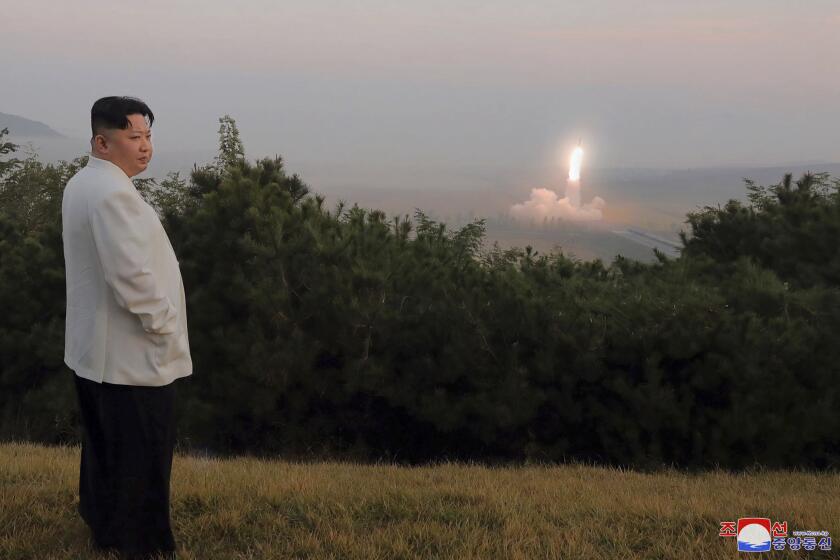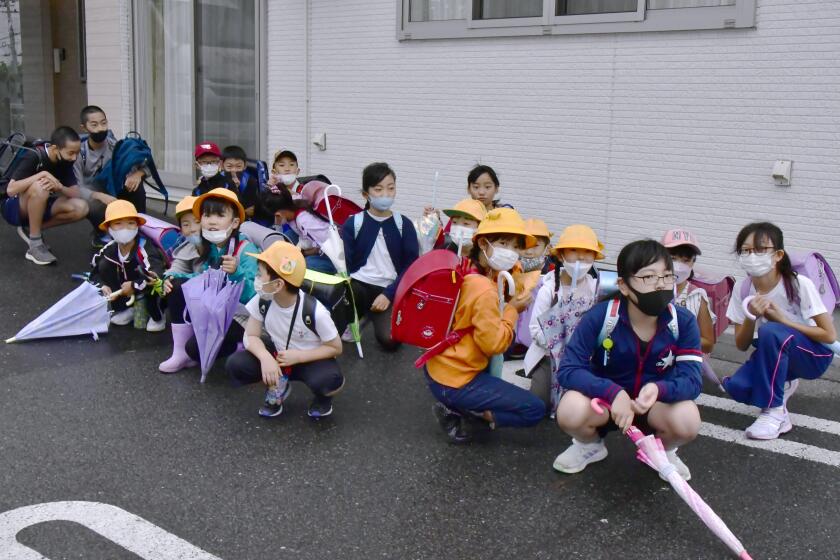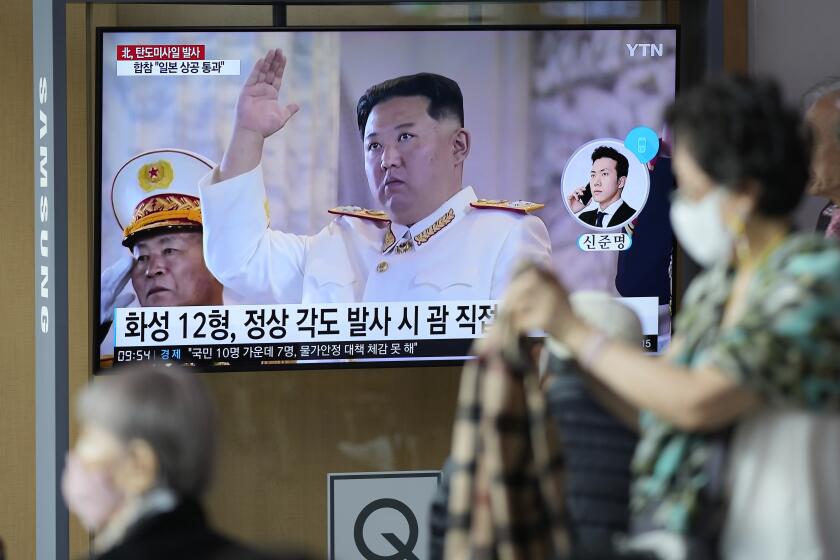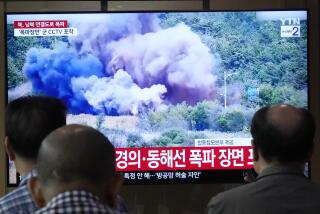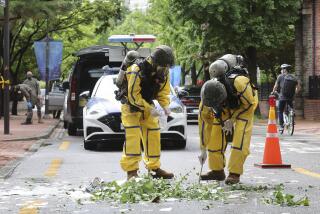North Korea keeps up its missile barrage with launch of ICBM
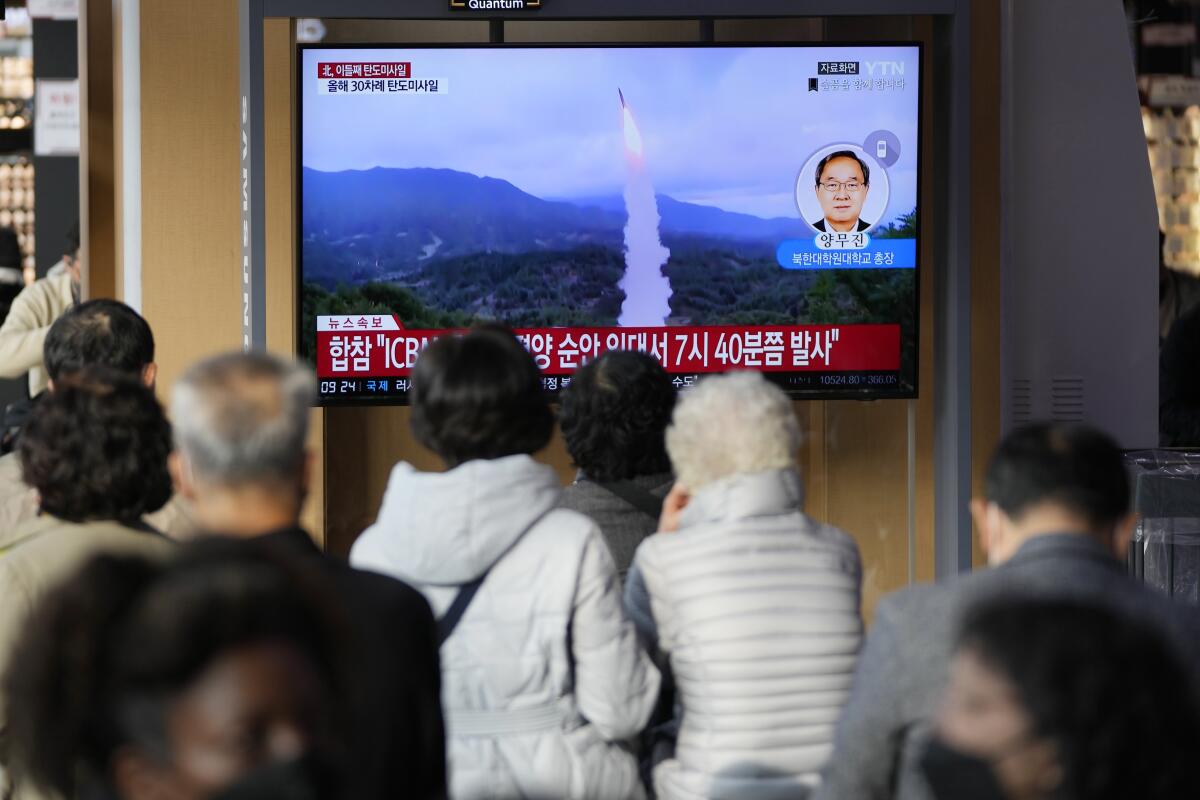
- Share via
SEOUL — North Korea fired at least six missiles into the sea on Thursday, including an intercontinental ballistic missile that triggered evacuation warnings and halted trains in northern Japan, adding to a recent barrage of weapons tests that has escalated tensions in the region.
The ICBM test was followed by launches of two short-range ballistic missiles in the morning, drawing swift condemnation by North Korea’s neighbors and the United States, which reacted by extending ongoing joint air force exercises with South Korea.
The South Korean and Japanese militaries said North Korea later fired three more short-range missiles into waters off its eastern coast. Those launches came an hour after a senior North Korean military official issued a statement threatening retaliation over the extension of the U.S.-South Korea drills. Japanese Defense Minister Yasukazu Hamada said the missiles traveled as far as 300 miles.
On Wednesday, North Korea fired more than 20 missiles, the most it has launched in a single day.
After already setting an annual record with dozens of ballistic launches in 2022, North Korea has further dialed up its testing activity since late September, including what it described as simulated nuclear attacks on South Korean and U.S. targets. It has said its tests are meant as a warning against the United States’ military drills with allies South Korea and Japan, exercises that Pyongyang portrays as rehearsals for a potential invasion.
Experts say North Korea is escalating brinkmanship aimed at forcing the United States to accept it as a nuclear power and at negotiating economic and security concessions from a position of strength.
North Korean leader Kim Jong Un signals more provocative tests to come after a series of missile launches designed to simulate use of nuclear weapons.
The Biden administration said in response to the launches that it is willing to take “all necessary measures” to ensure the safety of the American homeland as well as South Korea and Japan. It also warned of unspecified “additional costs and consequences” if North Korea ups the ante by detonating a nuclear test device for the first time since September 2017. U.S. and South Korean officials have been monitoring possible test preparations in North Korea for months.
On Thursday morning, South Korea’s Joint Chiefs of Staff said it detected that North Korea had fired an ICBM from an area near its capital, Pyongyang, and then two short-range missiles an hour later from the nearby city of Kaechon that flew toward its eastern waters.
The longer-range missile appeared to be fired at a high angle, possibly to avoid entering the territory of neighbors, reaching a maximum altitude of 1,193 miles and traveling 472 miles, according to South Korea’s military. It wasn’t immediately clear whether the launch was successful.
Japan said it lost track of one of the North Korean weapons, apparently the ICBM, after it “disappeared” in skies above waters between the Korean peninsula and Japan.
Choi Yong-soo, a South Korean navy captain who handles public affairs for Seoul’s Defense Ministry, didn’t answer directly when asked about the possibility of the ICBM launch being a failure, saying that it is still being analyzed.
Citing anonymous military sources, South Korea’s Yonhap news agency reported that the missile possibly failed to maintain a normal flight after a stage separation.
North Korea has fired a ballistic missile over Japan, its neighbors said, escalating tests of weapons designed to strike key targets in regional U.S. allies amid stalled nuclear diplomacy.
The Japanese government initially feared North Korea fired a missile over its northern territory but later adjusted its assessment. Japanese Chief Cabinet Secretary Hirokazu Matsuno said the alerts were based on a trajectory analysis that indicated a flyover.
The office of Japanese Prime Minister Fumio Kishida broadcast alerts through television, radio, cellphones and public loudspeakers to residents of the northern prefectures of Miyagi, Yamagata and Niigata, instructing them to go inside strong buildings or underground.
There have been no reports of damage or injuries in the regions where the alerts were issued. Bullet train services in some areas were temporarily suspended after the missile alert but resumed shortly afterward.
North Korean missile activity is a particular concern in Niigata, which is home to seven reactors at the Kashiwazaki-Kariwa nuclear power plant. Those reactors are offline, and Japanese authorities say no abnormalities have been detected.
On Sado island, just off Niigata’s northern coast, fishermen rushed back from sea at the sound of sirens blaring from community speaker systems. One fisherman told NTV television he no longer feels safe going out to sea.
“We really have to be careful,” he said.
North Korea last fired a missile over Japan in October in what it described as a test of a new intermediate-range ballistic missile, which experts say potentially would be capable of reaching Guam, a major U.S. military hub in the Pacific.
Kishida condemned the latest launches by North Korea and said officials were analyzing the details of the weapons. The office of South Korean President Yoon Suk-yeol said it will continue to expand military exercises with the United States. It said further launches would only deepen the North’s international isolation and unleash further economic shock to its people.
Adrienne Watson, a spokesperson for the U.S. National Security Council, issued a statement saying that the United States strongly condemns North Korea’s ICBM test and that President Biden and his national security team are assessing the situation in close coordination with allies and partners.
“This launch, in addition to the launch of multiple other ballistic missiles this week, is a flagrant violation of multiple U.N. Security Council resolutions and needlessly raises tensions and risks destabilizing the security situation in the region,” Watson said.
She said the United States will take all necessary measures to ensure the security of America and its allies South Korea and Japan.
One of the more than 20 missiles North Korea fired Wednesday flew in the direction of a populated South Korean island and landed near the rivals’ tense sea border, triggering air-raid sirens and forcing residents on Ulleung island to evacuate. South Korea quickly responded by launching its own missiles in the same border area.
Those launches came hours after North Korea threatened to use nuclear weapons to get the U.S. and South Korea to “pay the most horrible price in history” for the two nations’ ongoing military drills.
North Korea launched two ballistic missiles toward its eastern waters, as the U.S. redeployed an aircraft carrier near the Korean peninsula.
After North Korea’s earlier launches Thursday, the South Korean and U.S. air forces agreed to extend their combined aerial drills to step up their defense posture.
U.S. and South Korean forces have deployed more than 200 warplanes, including advanced F-35 fighter jets, for the exercises that were initially scheduled through Friday. South Korea’s air force didn’t immediately say how long the training will continue.
In a statement issued through state media, senior North Korean military official Pak Jong Chon accused the allies of pushing tensions to an “uncontrollable state” by extending their “provocative military acts.”
“The U.S. and South Korea will get to know what an irrevocable and awful mistake they made,” he said.
Experts say North Korea’s ramped-up tests show an effort to exploit a divide in the United Nations Security Council over Russia’s war in Ukraine as Pyongyang seeks to pursue weapons development and increase pressure on the U.S. and its regional allies.
North Korea has punctuated its tests with an escalatory nuclear doctrine that authorizes preemptive nuclear attacks over a variety of loosely defined crisis situations.
Experts say a North Korean nuclear test, which would be its seventh, could bring the country a step closer to its goal of building a full-fledged arsenal threatening regional U.S. allies and the American mainland.
“Should it go forward with a seventh nuclear test, there would be additional costs and consequences,” State Department spokesperson Ned Price said Tuesday, adding that the test would be a “dangerous, reckless, destabilizing act.”
Nuclear disarmament talks between Washington and Pyongyang have been stalled since 2019 because of disagreements over an easing of crippling U.S.-led sanctions against North Korea in exchange for denuclearization steps.
Yamaguchi reported from Tokyo. AP writers Aamer Madhani and Ellen Knickmeyer in Washington contributed to this report.
More to Read
Sign up for Essential California
The most important California stories and recommendations in your inbox every morning.
You may occasionally receive promotional content from the Los Angeles Times.
